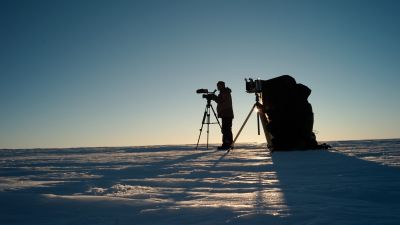
Scientific Research Closing Out the 2021-22 Season
The last teams of scienntists who are at the Princess Elisabeth Antarctica for the 2021-22 austral summer research season have been hard at work setting up instruments and collecting samples for their respective resaerch projects with the help of the staiton's technical team. Meanwhile, maintenance of the Princess Elisabeth Antarctica continues non-stop as preparations begin for putting the station in overwintering mode. There's less than a month left in the 2021-22 season!
-
Engineer Johnny Galens releases a radio sounder attached to a helium balloon to provide data for the BELSPO-funded ACME project lead by Alexander Mangold from the Royal Meteorological Institute of Belgium.
© International Polar Foundation
-
The new team arrives at Princess Elisabeth with scientists from three different research projects, a new cook, and an engineer. They are the last incoming team of the 2021-22 research season.
© International Polar Foundation
-
Steph & Ellie from the ANTISE project are still at PEA, collecting mummy accumulation (gut regurgitate) form snow petrels to study their nesting, breeding and feeding habits.
© International Polar Foundation
-
Steph & Ellie from the ANTISE project enjoying the view from Utsteinen Nunatak.
© International Polar Foundation
-
Bruno Danis from ULB (Belspo RECTO project) collects dead birds found in a colony to study the possible contamination by microplastics or other contaminants
© International Polar Foundation
-
The BELARE team equipped a sledge with a winch that will deploy a yoyo-cam to observe the seabed for the BELSPO-financed RECTO project, which seeks to survey biodiversity along the coast of the Dronning Maud Land in East Antartica.
© International Polar Foundation
-
Setup to be used by Bruno Danis for the BELSPO-financed RECTO project.
© International Polar Foundation
-
IPF engineer Nicolas Henrickx and Quinten Vanhellemont from RBINS construct a tripod to hold a field camera being set up to measure infrared radiation reflection for the Horizon2020 HYPERNETS project.
© International Polar Foundation
-
Quinten Vanhellemont from RBINS, who's working on the Horizon2020 HYPERNETS project, installs a Hypstar device to be tested in front of PEA.
© International Polar Foundation
-
The team dismantles and reorients a solar panel platform to make better use of the morning sun's rays to improve electricity production at PEA.
© International Polar Foundation
-
Paul Dudas and Tom Sage-Segard prepare large boards and specific anchorage points to protect that station's solar panels during the austral winter.
© International Polar Foundation
-
Removing snow from the station's solar panels installed on the western façade take a lot of manpower and the help of a Prinoth.
© International Polar Foundation












